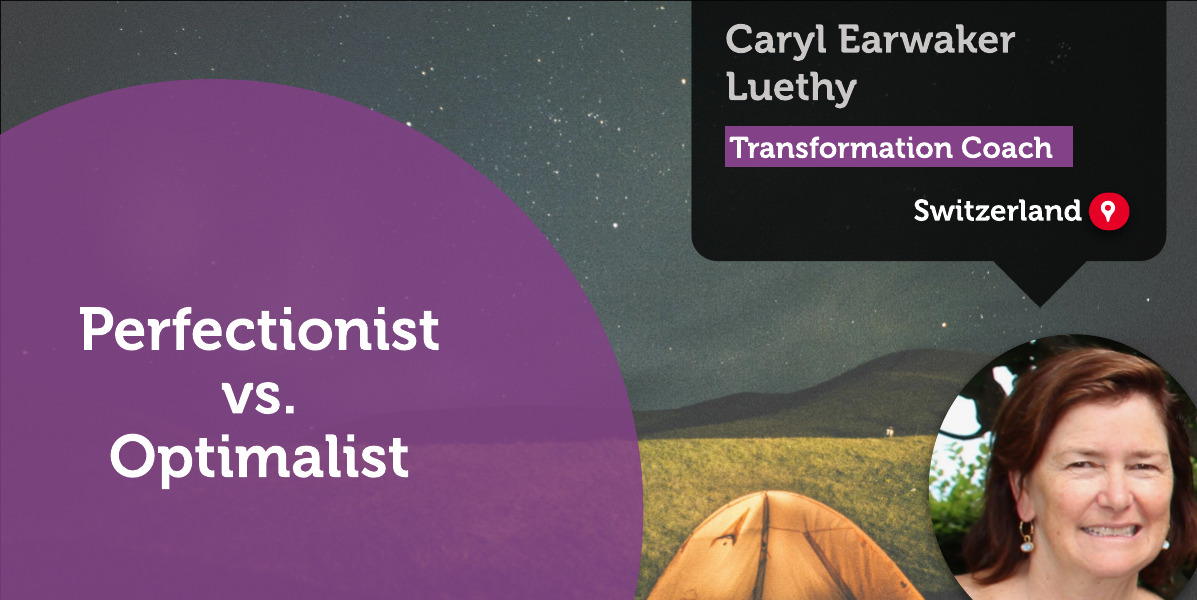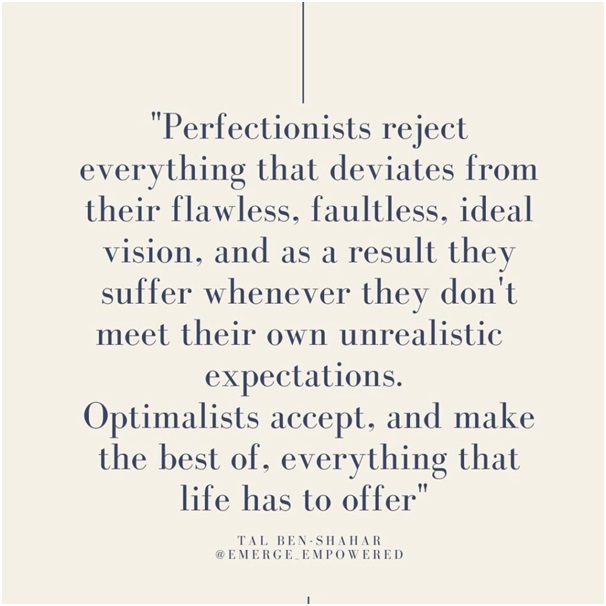A Coaching Power Tool By Caryl Earwaker Luethy, Transformation and Resilience Coach, SWITZERLAND

The Difference Between Being a Perfectionist vs. Optimalist

A Perfectionist is someone who has a personality that strives for flawlessness. This is often accomplished through fixating on imperfections, trying to control situations, working hard, or being critical of the self or others ( Scott, 2022 )
In this Power Tool, we will look at the two different forms of perfectionism – the traditional negative form of the Perfectionist and at the other end of the continuum –but in the positive form of a Perfectionist, which is an Optimalist.
What Can Create Perfectionism?
The origins of perfectionism will always be unique to each person but the seeds for Perfectionism may be found:
- Excessive praise for achievements as a child creates conditional self-worth based on achievements
- Rigid, high parental expectations pushing high performance
- High achieving perfectionist parents who modeled this way of thinking and acting
- A difficult childhood – Highly critical, shaming, or abusive parenting leading to perfectionist efforts to feel in control
- History of High Achievement – successful leaders who feel the overwhelming pressure to live up to past achievements
- Larger competition – academic and professional pressure for students to perform at the highest level
- Social Media creating Social Comparisons – by constantly comparing oneself to others and not feeling good enough
- Cultural Expectations – within organizational cultures or different ethnicities

The shield for protection can become a strong and rigid armor as the perfectionist strives for perfection as a way to gain acceptance, love, and praise. Unfortunately, this expression of perfectionism can lead to some of the following negative traits:
- Having goals that are often too high and difficult to achieve
- Conditional self-worth – based on achievement and productivity
- Being unable to accept imperfection. An underlying reason for perfection is the fear of criticism and rejection
- Excessive fear of failure
- Trying to present a perfect persona to the world, but being obsessed with imperfections and failures leads to harsh self-criticism.
- ‘Should’ statements create a lot of pressure and become rigid rules to follow
- Being defensive when receiving criticism because of wanting to look perfect
- Annoyed by others who don’t act or think the same way
- An excessive focus on control and the need to appear perfect to others can put pressure on interpersonal relationships and situations
- Trying to do the best for everyone everywhere, this superhuman approach sets the perfectionist up for frustration and disappointment
- Black and White thinking– labeling situations as either good or bad puts more pressure on as anything less than perfect becomes not good enough
- Catastrophic thinking – a minor mistake can be amplified out of proportion
- Procrastination – worrying about achieving the perfect outcome – finalizing ideas and making decisions becomes paralyzing as the fear of failure is often overwhelming
- Constantly revising and improving details –to get the perfect outcome
- Being unable to enjoy the present – by focusing on the future goal, one can’t enjoy the journey of learning along the way
- Being less resilient in recovering from setbacks because of a tendency to want to stay in the ‘positive’ state and not have negative feelings – this toxic positivity can lead to ‘negative emotions gaining strength’ (Holuk, 2016)
- Not celebrating success – by focusing on imperfections in completed projects, the perfectionist wants to move immediately on to the next project on the list
When perfectionism has the Perfectionist in its grip, the internal pressure can become a disempowering loop and cause a range of reactions including unhappiness, stress, anxiety, insomnia, depression, other mental health issues, general health problems, and pain syndromes.
And Who Is an Optimalist?
I particularly relate to Tal Ben- Shahar reference to the Optimalist as being a ‘healthy Optimist’ who is in touch with reality.

Traits of an Optimalist :
- a healthy Optimist
- a perfectionist in the positive form with life in balance
- Setsoptimal standards that are ‘good enough
- Combines their goals realistically with what is physically possible
- Constructs an optimal life within healthy boundaries – realizing there are only so many hours in the day
- Values challenges and failures as important for personal growth
- Enjoys being challenged and values constructive criticism as an opportunity for growth
- Sets adaptable, realistic goals
- Is willing to experiment and take risks along the way
- Accepts and appreciates self and others with compassion
- Being comfortable expressing and receiving positive and negative emotions and is, therefore, more resilient
- Can celebrate successes
Transforming from Perfectionist vs. Optimalist
Perfectionists often regard being a Perfectionist as one of their strengths; it drives them to excel and be exceptional. It pushes them to meet their goals and live up to their standards. The constant striving for excellence is seen as a critical part of their identity. It is difficult for them to imagine being any other way and maintaining their self-esteem. (Grande, 2021)
That’s fine if she is able to keep life in balance but when Perfection unleashes itself in the negative form, it can become a beast of mythological proportions. The aim is not to slay it, as it is part of us. Without it, we would not be who we are. We don’t want to kill the beast, we just want to tame it (Ludeke, 2014 ).
Coaching Application: Transformation from Perfectionist to Optimalist
To tame the Perfection beast, the good news is that nobody is ever fully a perfectionist. It may be difficult and a long road, but we all have the potential to let go of the shackles of perfectionism. If a label is needed–then in the positive active form – the recovering Perfectionist, is more constructive. As we all know in the coaching arena, with neuroplasticity and positive psychology – what we focus on, grows stronger. Although it is helpful to understand the label of Perfectionist, I encourage clients to let this label go and focus on moving towards becoming an ‘Optimalist’. By not focusing on the negative traits of Perfectionism or the label of Perfectionist, we avoid feeling stuck or disempowered.
The following ideas have their roots in my ICA Pearl Coaching Model – ‘Growing a Pearl: Empowering Women to become Strong, Positive, Confident and Resilient. As a recovering Perfectionist and reflecting on the other Perfectionists that I know, we are often inherently strong, positive, confident, and resilient and just need the space to get back in balance with this positive side of Perfectionism.
Considerations for coaching are:
-
Awareness
The coaching space provides a safe sanctuary for clients to take a closer look at how perfection shows up in their lives and what they want to do with it. The biggest step has already been taken through coming to coaching. The awareness of being a Perfectionist is an empowering and pivotal point where the client can unpack their underlying beliefs, values, thoughts, and feelings around the topic and start to take control back in their life. Transparency is the key here – though knowledge comes with understanding and self-compassion.
- Authenticity
Coaching involves empowering the client to move forwards, exploring and using new insights to gradually move along the continuum towards Optimalist. By the Coach being authentic, natural, and deeply empathetic in their approach, the client can also connect with their authentic self and her intuition. When the true self can emerge, the potential for real progress in the right direction is limitless.
-
Positivity
By taking a lighter, optimistic approach, the client will be encouraged to shine a positive light on their situation. A combination of gratitude for what is, acceptance of what was, and trust in the future, can build a strong foundation for real change.
-
Stepping Back
By stepping back and looking at the bigger picture closely, the client is able to funnel down and prioritize what change she wants to make in the broader sense. In this way, things are not so overwhelming and it is easier to prioritize what is really important to find a way forwards – step by step. Stepping into the ideal feelings helps to set a positive foundation for the coaching.
-
Small Steps
When planning, it could be helpful to have small achievable steps, so that the direction can be easily adapted and flexible to change. Chunking into small SMART goals takes the focus away from an overwhelming bigger picture to making it simpler and immediately accessible and achievable.
-
Facing Fears
The coach can support the client to have the courage to face their fears by helping them understand that the only way to become courageous is to practice being courageous (Holuk, 2016). With perfectionism, the main fears are a failure, making mistakes, and being judged. When we shine the spotlight on our fears, we realize that they are not as big as we thought, and as Nike preaches – developing the ‘Just do it attitude and facing fears head-on, builds confidence and self-esteem to step outside of the perfectionist mindset. The coaching space can support clients as they grow through this experimentation and develop a braver heart.
-
Practicing Imperfection
To begin the journey to or back to the Optimalist, it is necessary to walk the path between failure and success. By taking a lighter approach to imperfection and practicing it over and over again, the client learns to feel comfortable with imperfection and can accept and value themselves as they indeed are – strengths, weaknesses, and everything in between. This courage to be able to take risks and not be perfect has the ‘power to break the paralysis of perfectionism’ (Ludeke, 2014)and rebuild self-worth and confidence.
-
Resilience
By taking the time and space to uncover, experience, and make friends with the full range of feelings, the client can learn to become ‘discomfortable’ ie. comfortable with discomfort, around negative feelings. By accepting that it is okay and normal to have negative feelings, she can become more flexible and confident in herself, more resilient to setbacks, and more relaxed in her relationships.
The focus is also on remembering strengths and past accomplishments to challenge disempowering beliefs and build self-confidence, further enhancing resilience.
-
Letting Go
Through the gradual development of confidence and self-worth in the coaching process, the client will notice what serves her well in life and what she would like to let go of. By letting go of outdated beliefs and/or behaviors, the client will be freed up and have the space to move forward and let new awarenesses and ways of being come into her life.
Some Coaching Questions to Help This Transformation to Optimalistcould Be:
- Perfection is an armor to protect and defend – what would it be like – not to have to wear it?
- What’s important about making this change now?
- What impact will it have when you have achieved this goal?
- What would be a step that we could work on today to begin this journey?
- What difference will this make when you can achieve this small step today?
- If you could make a wish, what would you change?
- What will the new feeling be when you tick the box with this small step?
- What do we need to address to get started?
- What has driven you to get where you are?
- Where would you like to be?
- What’s important about getting there?
- How has having high personal expectations held you back?
- How has having high expectations helped you?
- What aspects of your current behavior would you like to carry forward?
- What would it take to make friends with all of your emotions?
- What would it feel like to let go of the word ‘should’?
- How could you make friends with this inner critic? How could it be trying to help you?
- What would you like to let go of?
- How might your life change if you could let go?
- What would it feel like to be able to let go?
- What expectations do you have of yourself?
- What expectations do you have of others?
- What expectations would you like to let go of?
- What are you worried about?
- What are you afraid of?
- What would it feel if you could chip away at that fear?
- If we were to look at your whole life, how would you describe yourself?
- How would others describe you?
- What has been important up till now, with doing things the best you can?
- What would it be like if you could drop the bar of perfection?
- What would be the worst that could happen?
- What would be the best that could happen?
- What would you be prepared to start with?
- What excites you?
- What do you feel grateful for?
- How do you nurture yourself?
- What could you do to settle your mind?
- What little experiment could you do today with imperfection?
- What would you like to do today, to celebrate the progress you have made?
My aim for coaching is to provide a sanctuary where clients can find their true self and their own wisdom, lift off the cloak of perfectionism and walk forwards with a sense of freedom and inspiration. To have a ‘good enough life and stay on the journey to a place of peace, satisfaction, and true happiness (Horne, 2009).
All of us may go through periods of our lives where we will be sitting along the continuum anywhere from Perfectionist to Optimalist. The awareness that I am a recovering Perfectionist, has been enlightenment – this understanding is helping pave the way to a new healthier perspective and I am committed to letting go more of my perfectionist traits as I set sail back in the Optimalist direction. I have written more in-depth about my experience in another ICA paper ‘Confessions of a Recovering Perfectionist – A Case Study – The Cycle of Perfectionism.’
By embracing and celebrating our imperfections, we can still be high achievers, but with a clear mind and a brave heart – be more resilient and move forwards as Optimalists.
One of the basic rules of the universe is that nothing is perfect, Perfection simply does not exist….without imperfection – neither you nor I would exist – Stephen Hawking
References
Brown, Brené www.goodtherapy.org
Gilmartin, Brianna. 2022 www.verywellmind.com Traits of Perfection
Grande, Dianne. 2021 www.psychologytoday.com When Perfection harms your relationships
Henderson, Gabrielle. 2021 www.theconversation.com How to avoid Toxic Positivity and take the less direct route to Happiness
Holuk, Cathy. 2016 Understanding Perfectionism and its Implications to the Coaching Experience
Horne, Amanda. 2009 www.positivepsychologynews.com Permission to be an Optimalist
Johnson, Brian. 2012 www.brianjohnson.me How to quit being a Perfectionist
Lacroix, Alain. www.dreamstime.com Perfectionist and Optimalist
Ludeke, Eric.2014 Coaching Power Tool: Sufficiency vs. Perfectionism
Martin, Sharon www.livewellwithsharonmartin.com
Scott, Elizabeth. 2022 www.verywellmind.com 10 Signs you may be a Perfectionist
www.goodtherapy.org Perfectionism
www.psychcentral.com What causes Perfectionism
www.psychologytoday.com Perfectionism
Pictures:
Girl at table: Jula Aniol, www.julaaniol.com Perfection – what it is and how to overcome it
Traits of Perfectionism: by Brianna Gilmartin www.verywellmind.com